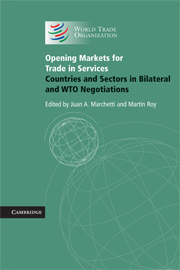Book contents
- Frontmatter
- Contents
- List of figures
- List of tables
- List of boxes
- List of contributors
- Foreword
- Acknowledgments
- Disclaimer
- Summary and overview
- PART I From Policy to Negotiations
- PART II Multilateral and Bilateral Negotiations on Services: Overall Perspectives
- PART III Challenges, Issues and Opportunities in Services Sectors
- 4 Telecommunications: can trade agreements keep up with technology?
- 5 The liberalization of cross-border trade in services: a developing country perspective
- 6 Out of stock or just in time? Doha and the liberalization of distribution services
- 7 Air transport liberalization: a world apart
- 8 Financial services liberalization in the WTO and PTAs
- 9 Beyond the main screen: audiovisual services in PTAs
- 10 The liberalization of postal and courier services: ready for delivery?
- 11 The liberalization of energy services: are PTAs more energetic than the GATS?
- 12 Market access for the government procurement of services: comparing recent PTAs with WTO achievements
- 13 A warmer welcome? Access for natural persons under PTAs
- PART IV Country Experiences with Services Trade
- Index
- References
12 - Market access for the government procurement of services: comparing recent PTAs with WTO achievements
Published online by Cambridge University Press: 05 December 2011
- Frontmatter
- Contents
- List of figures
- List of tables
- List of boxes
- List of contributors
- Foreword
- Acknowledgments
- Disclaimer
- Summary and overview
- PART I From Policy to Negotiations
- PART II Multilateral and Bilateral Negotiations on Services: Overall Perspectives
- PART III Challenges, Issues and Opportunities in Services Sectors
- 4 Telecommunications: can trade agreements keep up with technology?
- 5 The liberalization of cross-border trade in services: a developing country perspective
- 6 Out of stock or just in time? Doha and the liberalization of distribution services
- 7 Air transport liberalization: a world apart
- 8 Financial services liberalization in the WTO and PTAs
- 9 Beyond the main screen: audiovisual services in PTAs
- 10 The liberalization of postal and courier services: ready for delivery?
- 11 The liberalization of energy services: are PTAs more energetic than the GATS?
- 12 Market access for the government procurement of services: comparing recent PTAs with WTO achievements
- 13 A warmer welcome? Access for natural persons under PTAs
- PART IV Country Experiences with Services Trade
- Index
- References
Summary
The treatment of services in preferential trade agreements provides an important point of comparison with their treatment in the multilateral trading system. Recently, several studies have examined aspects of the treatment of services in PTAs. These analyses have provided insights into a number of important questions: (a) To what extent are countries willing to make broader and deeper commitments regarding services liberalization in PTAs as compared to the GATS? (b) Why is this so? (c) What costs does the proliferation of such commitments entail? (d) Can such commitments serve as building blocks for multilateral liberalization, or are they more likely to undermine it? An important related question concerns possibilities for the eventual multilateralization of commitments on services liberalization in PTAs (Baldwin, Evenett, and Low, 2007).
To date, analysis of the treatment of services in PTAs has focused on provisions governing trade in services that are purchased by private entities. These provisions are important in their own right and provide a logical point of comparison with the treatment of services in the GATS. The focus on commercial trade in services overlooks another important component of services trade, however, namely the government procurement of services. To the extent that it is regulated by PTAs, government procurement is usually governed not by the general services provisions of such agreements, but by their provisions on the government procurement of services and goods.
- Type
- Chapter
- Information
- Opening Markets for Trade in ServicesCountries and Sectors in Bilateral and WTO Negotiations, pp. 435 - 474Publisher: Cambridge University PressPrint publication year: 2009

